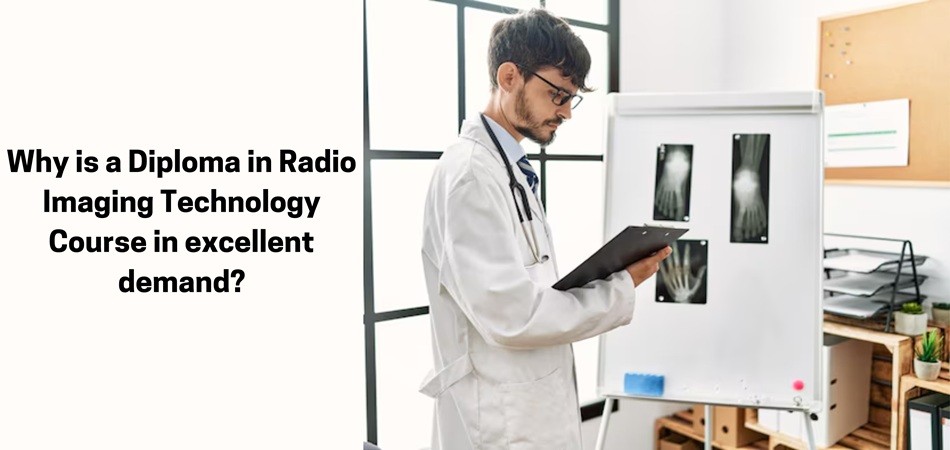Why Is a Diploma in Radio Imaging Technology Course in Excellent Demand?

The increasing demand for a Diploma in Radio Imaging Technology course (DRIT) is a reflection of the evolving healthcare and the critical role that radiology plays in modern medical practices.
This course equips students with essential skills to operate advanced imaging technologies, interpret diagnostic results, and ensure patient safety.
Thus, making the DRIT course an attractive option for those entering the healthcare field.
Overview of the DRIT Course
The DRIT course duration is typically structured as a two-year diploma program that combines theoretical knowledge with practical training. Students learn various imaging techniques, including X-ray, MRI (Magnetic Resonance Imaging), and CT (Computed Tomography) scans. The curriculum covers core subjects such as:
- X-ray Imaging Techniques
- Radiation Safety and Protection
- MRI and CT Scan Procedures
- Anatomy, Physiology, and Pathology for Radiology
- Patient Care in Radiology
This comprehensive training ensures that graduates are well-prepared to meet the demands of healthcare facilities by including hospitals, diagnostic labs, and research institutions.
Rising Demand for Radiology Professionals
Several factors contribute to the heightened demand for radiology professionals. The aging population is one significant aspect; as individuals age, they often experience an increase in chronic conditions that necessitate regular imaging services. Diseases such as osteoporosis, arthritis, and cancer require frequent diagnostic imaging to monitor and guide treatment plans.
Moreover, an exponential rise in chronic diseases globally including heart disease and diabetes also relies heavily on imaging for diagnosis and management. The need for skilled radiologic technologists to perform these critical tests increases significantly.
Technological advancements in medical imaging have further fueled this demand. New imaging modalities provide more detailed and accurate results by necessitating trained professionals who can operate sophisticated equipment effectively.
The current workforce is experiencing a shortage of skilled radiologic technologists. Further, recent surveys indicate vacancy rates have surged dramatically due to retirements and the growing need for imaging services.
Career Opportunities Post-Diploma
Graduates of the DRIT course can explore various career paths within the healthcare sector. Some prominent roles include:
- Radiologic Technologist/Technician: Responsible for performing diagnostic imaging procedures.
- MRI Technologist: Specializes in operating MRI machines.
- CT Technologist: Focuses on conducting CT scans.
- Radiology Supervisor/Manager: Oversees operations within radiology departments.
The versatility of skills acquired through the DRIT program allows graduates to pursue advanced roles or specialize further in areas such as radiation therapy or interventional radiology. Additionally, opportunities exist internationally due to the global transferability of skills learned during training.
Skill Development Through the DRIT Course
The Diploma RIT course in Delhi /NCR emphasizes technical and soft skills essential for success in clinical settings.
Technical Skills
Graduates gain proficiency in:
- Operating Imaging Equipment: Mastery of X-ray machines, MRI scanners, and CT devices.
- Radiation Safety Protocols: Knowledge of safety measures to protect patients and staff from radiation exposure.
- Diagnostic Accuracy: Ability to capture high-quality images necessary for accurate diagnoses.
Soft Skills
In addition to technical training, students develop vital soft skills:
- Communication: Effectively interacting with patients to ensure comfort during procedures.
- Teamwork: Collaborating with healthcare professionals for comprehensive patient care.
- Attention to Detail: Ensuring precision in imaging results and adherence to safety protocols.
These competencies make DRIT graduates highly employable from day one.
Explore Everything About the Course!
The Diploma in Radio Imaging Technology stands out as a vital educational pathway in a rapidly growing field. The blend of technical expertise and essential soft skills prepares graduates not only for immediate employment but also for long-term career advancement within healthcare.
Seeking one of the best DRIT course details? Reach out to Ganesh Paramedical College for admission queries. As the demand for radiology professionals continues to grow, those entering this field can expect a rewarding and impactful career dedicated to improving patient outcomes through advanced medical imaging technology.
Frequently Asked Questions (FAQ)
1. What are the eligibility criteria for enrolling in a DRIT course?
Applicants must have completed 10+2 education, preferably with science subjects like Physics, Chemistry, and Biology. Some institutions may require entrance exams.
2. How long does it take to complete a DRT course?
The Diploma in Radio Imaging Technology typically takes two years to complete, though some institutions may offer accelerated or part-time options.
3. What career opportunities are available after completing the DRT course?
Graduates can work as radiologic technologists, MRI or CT scan specialists, or pursue supervisory roles in radiology departments globally.

